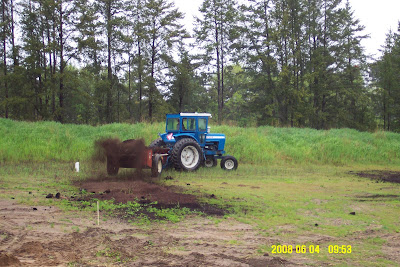The styrofoam roof of the cottage is looking good in its new fascia. Now it's time to get it ready for the finish coat of cob.
On the east and west walls of the greenhouse, the OSB has been shingled with roll roofing and stapled with chicken wire.


I've posted before about our difficulties in sealing joints at the edges of straw bales. Montalban is putting in some do-over time, cramming more flax straw in around the windows.




The crater area continues to green up. The rest of the seeded areas around the cottage are only just starting to show a few sprouts. It hasn't rained very much since planting day.


The potato patches have come up nicely, all except the Norkotas which are almost a complete bust. The wheat straw Flora gave me for mulch turned out to be kind of a mistake - it was full of seeds and a lot came up, requiring hand-weeding of the whole doggone thing. Flora was very apologetic, said she hadn't used that exact kind of straw before and hadn't had such a problem with the usual flax straw. She helped me weed.




Yesterday your correspondent had the privilege of attending part of a board meeting for our client, Happy Dancing Turtle. One of the board members, let's call her Ray-man, is you might say a skeptic or at least not inclined to be any kind of early adopter of any of this sustainability stuff. "I'll do it if it's convenient."
Us sustainnibals and peakniks encounter these situations from time to time, opportunities to witness to the unconverted. I feel like we more or less blew it again. I maybe should have said something like, "We're working on it. We'll try to make it convenient, and by 'try' I mean lives, fortunes, sacred honor, but I gotta tellya, I think the way this is likely to play out is not so much that the sustainable life gets more convenient, but that the unsustainable life gets steadily less convenient - less customers in your video store, the price of gas, food, and everything else going up. Steadily if we're lucky and there isn't some kind of outage or shortage. That's why I'm trying to learn how to live sustainably now."
Let me reinforce that in our News of the Future segment with a couple of articles from the fine web site www.energybulletin.net. Here Dave Cohen talks the near-term economic consequences of oil addiction for the US. Here John Greer eloquently makes a point I've discussed with friends, that our intricate human civilization is more vulnerable to climate change than a thin-skinned tree frog.









































